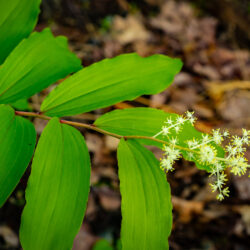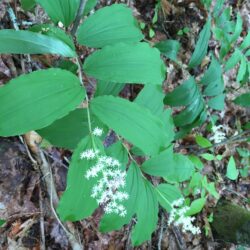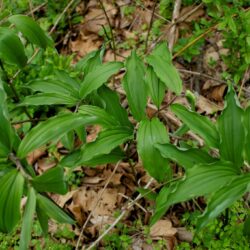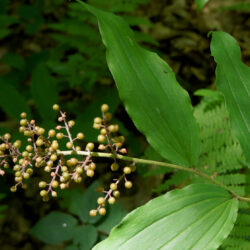Etymology
Maianthemum is Latin for May flower; racemosum is Latin for cluster or bunch, referring to the flower configuration.
Native Habitat
Moist deciduous forests.
Garden Uses
As a landscaping plant in shade or forest border. It may be most effective in groupings of 6 or more plants.
Overview
Common to moist deciduous forests of the eastern US, this stately perennial herb reaches a height of 1-3 feet, developing first a plume-like cloud of tiny white flowers, and then edible red berries. Undisturbed, they can spread slowly by rhizomes, forming large colonies in shaded groves.
Leaves and Stems
Leaves are glossy green, smooth, simple, elliptical (lance-like or oval), and generally measure up to 6 inches in length and 1 inch in width. They form two alternate rows, one on each side of the green stem, with some on short petioles (stalks). Each leaf has strong parallel veins. Each rhizome branch can have one or several stems with a flower cluster born at the tip.
Flowers
Blooms form a terminal panicle (many branched flower cluster), with each branch a raceme (smaller cluster) of from a few to hundreds of tiny white flowers, each less than 1/4 inch, providing a feathery appearance. Each flower has 6 tepals, 6 stamens, and a central pistil.
Fruit/Seed
A fleshy 1/2-inch berry is formed by each flower and filled with two or more seeds. The fruit starts green, becomes mottled with purple, and ripens to red, sometimes with purple markings.
Wildlife Associates
This plant is pollinated by small, native bees, flies, and beetles. Its fruit feeds both birds and rodents.
Propagation
Plant rhizomes can be divided in the autumn. Flowering will be decreased for a year or two post disturbance. Fresh seeds can also be planted in the autumn.
Ethnobotanical Uses
Some Native Americans used the root and leaves medicinally as well as the young shoots.
Garden Location
Performance Hall Garden (see garden map)
Anecdotal Information
Deer have been a problem for plants in the native garden.
Sources
Lady Bird Johnson Wildflower Center
Plant Profile by Kate O’Dell





